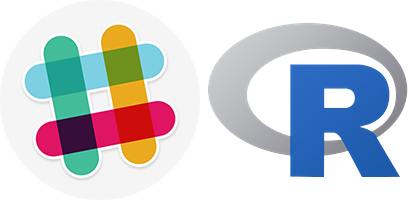Copyright: Bob Rudis @hrbrmstr, http://rud.is/b
Original source: https://github.com/hrbrmstr/slackr
slackr - a package to send user messages & webhook API messages to Slack channels/users
The slackr package contains functions that make it possible to interact with the Slack messaging platform. When you need to share information/data from R, rather than resort to copy/paste in e-mails or other services like Skype, you can use this package to send well-formatted output from multiple R objects and expressions to all teammates at the same time with little effort. You can also send images from the current graphics device, R objects (as R data files), and upload files.
Versions 1.4+ BREAK THINGS.
Support has been removed for the "old style" incoming web hooks (see "Setup" below for the required incoming web hook URL format).
The incoming webhook "token" is no longer required or used.
- Version
1.4.0.9000newslackr_msg()+ many fixes and BREAKING CHANGES (see above) - Version
1.3.1.9000Removeddata.tabledependency (replaced withdplyr); added access toim.list(https://api.slack.com/methods/im.list) thx to PR from Quinn Weber - Version
1.3.0.9000Radically changed howslackrworks. Functions have camelCase and under_score versions - Version
1.2.3added more parameter error cheking, remobved the need for ending?on webhook URL and added defaults for missing setup parameters. - Version
1.2.2fixed issue (bug in1.2.1fix) - Version
1.2.1fixed issue when there are no private groups defined - Version
1.2re-introducedggslackr()(first CRAN version) - Version
1.1.1fixed a bug in the new full APIslackr()function - Version
1.1added graphics & files capability - Version
1.0released
Many thanks to:
for their contributions to the package!
The following functions are implemented:
slackr_setup: initialize necessary environment variablesslackr: send stuff to Slackslackr_bot: send stuff to Slack using an incoming webhook URLdev_slackr: send the graphics contents of the current device to a to Slack channelggslackr: send a ggplot object to a Slack channel (no existing device plot required, useful for scripts)save_slackr: save R objects to an RData file on Slackslackr_upload: upload any file to Slackslackr_users: get a data frame of Slackslackr_channels: get a data frame of Slackslackr_groups: get a data frame of Slack groupstext_slackr: Send regular or preformatted messages to Slackslackr_msg: Slightly different version oftext_slackr()
The slackr_setup() function will try to read setup values from a ~/.slackr (you can change the default) configuration file, which may be easier and more secure than passing them in manually (plus, will allow you to have multiple slackr configs for multiple Slack.com teams). The file is in Debian Control File (DCF) format since it really doesn't need to be JSON and R has a handy read.dcf() function since that's what DESCRIPTION files are coded in. Here's the basic format for the configuration file:
api_token: YOUR_FULL_API_TOKEN
channel: #general
username: slackr
incoming_webhook_url: https://hooks.slack.com/services/XXXXX/XXXXX/XXXXX
You can also change the default emoji icon (from the one you setup at integration creation time) with icon_emoji.
# stable/CRAN
install.packages("slackr")
# bleeding edge
devtools::install_github("hrbrmstr/slackr")library(slackr)
# current verison
packageVersion("slackr")
#> [1] '1.4.1'slackrSetup(channel="#code",
incoming_webhook_url="https://hooks.slack.com/services/XXXXX/XXXXX/XXXXX")
slackr(str(iris))
# send images
library(ggplot2)
qplot(mpg, wt, data=mtcars)
dev.slackr("#results")
barplot(VADeaths)
dev.slackr("@jayjacobs")
ggslackr(qplot(mpg, wt, data=mtcars))library(slackr)
library(testthat)
date()
#> [1] "Tue Apr 26 17:55:41 2016"
test_dir("tests/")
#> testthat results ========================================================================================================
#> OK: 0 SKIPPED: 0 FAILED: 0